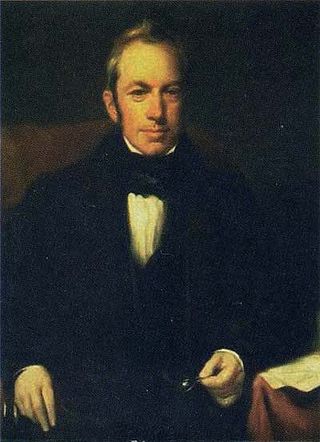
Robert Brown was a Scottish botanist and paleobotanist who made important contributions to botany largely through his pioneering use of the microscope. His contributions include one of the earliest detailed descriptions of the cell nucleus and cytoplasmic streaming; the observation of Brownian motion; early work on plant pollination and fertilisation, including being the first to recognise the fundamental difference between gymnosperms and angiosperms; and some of the earliest studies in palynology. He also made numerous contributions to plant taxonomy, notably erecting a number of plant families that are still accepted today; and numerous Australian plant genera and species, the fruit of his exploration of that continent with Matthew Flinders.

Brodiaea, also known by the common name cluster-lilies, is a monocot genus of flowering plants.
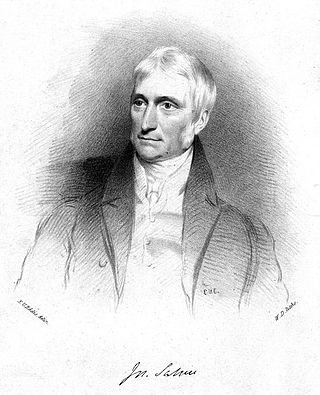
Joseph Sabine FRS was an English lawyer, naturalist and writer on horticulture.

Richard Anthony Salisbury, FRS was a British botanist. While he carried out valuable work in horticultural and botanical sciences, several bitter disputes caused him to be ostracised by his contemporaries.

Bouvardia is a genus of flowering plants in the family Rubiaceae. It contains about 50 species of evergreen herbs and shrubs native to Mexico and Central America, with one species extending into the southwestern United States. The genus is named in honor of Charles Bouvard (1572–1658), physician to Louis XIII, and superintendent of the Jardin du Roi in Paris.
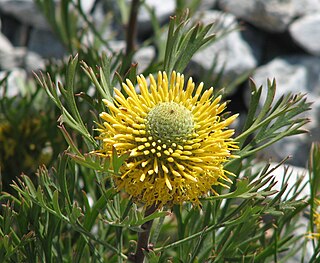
Isopogon anemonifolius, commonly known as broad-leaved drumsticks, is a shrub of the family Proteaceae that is native only to eastern New South Wales in Australia. It occurs naturally in woodland, open forest, and heathland on sandstone soils. I. anemonifolius usually ranges between one and two metres in height, and is generally smaller in exposed heathland. Its leaves are divided and narrow, though broader than those of the related Isopogon anethifolius, and have a purplish tinge during the cooler months. The yellow flowers appear during late spring or early summer and are displayed prominently. They are followed by round grey cones, which give the plant its common name drumsticks. The small hairy seeds are found in the old flower parts.
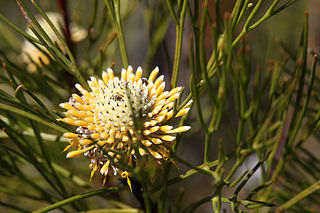
Isopogon anethifolius, commonly known as narrow-leaf drumsticks or narrow-leafed drumsticks, is a shrub in the family Proteaceae. The species is found only in coastal areas near Sydney in New South Wales, and to the immediate west. It occurs naturally in woodland, open forest and heathland on sandstone soils. An upright shrub, it can reach to 3 m (9.8 ft) in height, with terete leaves that are divided and narrow. The yellow flowers appear in the Spring, from September to December, and are prominently displayed. They are followed by round grey cones, which give the plant its common name of drumsticks. The small hairy seeds are found in the old flower parts.

Grevillea mucronulata, also known as green spider flower or green grevillea, is a species of flowering plant of the family Proteaceae and is endemic to New South Wales in Australia. Described by Robert Brown in 1810, it is found in open sclerophyll forest or woodland around the Sydney region and New South Wales south coast. It grows as a small bush to 3 m (9.8 ft) high and wide, with variable foliage and greenish flowers that appear over the cooler months from May to October. The flowers are attractive to birds.
William Jack FRSE was a noted Scottish botanist and medical practitioner.

On the natural order of plants called Proteaceae, also published as "On the Proteaceae of Jussieu", was a paper written by Robert Brown on the taxonomy of the plant family Proteaceae. It was read to the Linnean Society of London in the first quarter of 1809, and published in March 1810. It is significant for its contribution to the systematics of Proteaceae, and to the floristics of Australia, and also for its application of palynology to systematics.
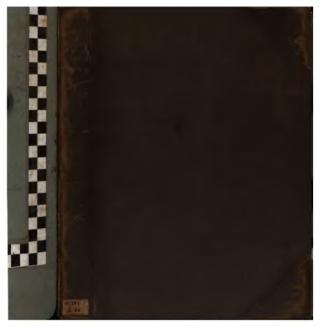
On the cultivation of the plants belonging to the natural order of Proteeae is an 1809 paper on the family Proteaceae of flowering plants. Although nominally written by Joseph Knight as a paper on cultivation techniques, all but 13 pages consists of an unattributed taxonomic revision now known to have been written by Richard Salisbury.

Edward Rudge was an English botanist and antiquary.

Baeckea brevifolia is a species of flowering plant in the family Myrtaceae and is endemic to south-eastern New South Wales. It is a shrub with narrow egg-shaped to oblong leaves and white to pink flowers with nine to fifteen stamens.

Lomatia silaifolia, commonly known as crinkle bush or parsley fern, is a plant of the family, Proteaceae native to eastern Australia. Naturally found in open forest, it grows as a small shrub 1–2 m high with highly pinnate leaves reminiscent of parsley. The white inflorescences appear in summer.

The Paradisus Londonensis is a book dated 1805–1808, printed by D.N. Shury, and published by William Hooker. It consists of coloured illustrations of 117 plants drawn by William Hooker, with explanatory text by Richard Anthony Salisbury.
Palicoureeae is a tribe of flowering plants in the family Rubiaceae and contains about 817 species in 11 genera. Its representatives are found in the tropics and subtropics.

Baeckea linifolia, commonly known as swamp baeckea, weeping baeckea or flax-leaf heath myrtle, is a species of flowering plant in the family Myrtaceae and is endemic to eastern Australia. It is an erect shrub with linear leaves and small white flowers with eight to fifteen stamens.
Herbert Fuller Wernham was a British botanist, who from 1909 to 1929 worked at the British Museum, as an assistant in the botany department. From 1911 to 1921 he published extensively on tropical plants and many genera, retiring in 1921 due to ill health (alcoholism).
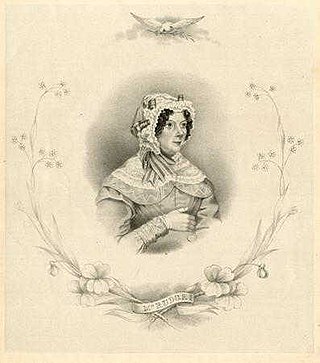
Anne Rudge was a British botanical illustrator who illustrated the works of her husband, the botanist Edward Rudge and her son, the barrister and antiquary Edward John Rudge, among others. She is one of the earliest known published female botanical artists, as, unlike many other female artists in her field at that time, she signed her work.
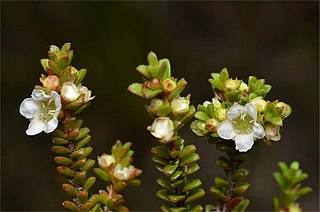
Baeckea diosmifolia, commonly known as fringed baeckea, is a species of flowering plant in the family Myrtaceae and is endemic to eastern Australia. It is a shrub with lance-shaped leaves with the narrower end towards the base, and white flowers with seven to nine stamens.

















